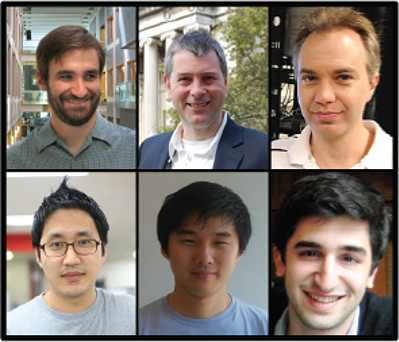SEAS Students Win a Second Qualcomm Innovation Fellowship
Having won a 2012 Qualcomm Innovation Fellowship (QInF) a year ago, electrical engineering PhD candidates Sunwoo Lee and Michael Lekas have put their $100,000 award to such good use that they have now won a 2013 QInF, for another $100,000.
Working under the supervision of professors Kenneth Shepard (electrical engineering) and James Hone (mechanical engineering), they collaborated with Changhyuk Lee, a PhD candidate in Professor Alyosha Molnar’s group at Cornell, to use graphene, a sheet of carbon a single atom thick that has outstanding electrical properties and is the world’s strongest material, to develop smaller, more flexible, and more frequency-selective on-chip filters that could lead to improved wireless devices: “Graphene Resonator Based Mixer-First Receiver on CMOS for Digitally Controlled and Widely Tunable RF Interface.”

Clockwise, from top left, Professors Alyosha Molnar, James Hone, and Kenneth Shepard, and PhD Candidates Michael Lekas, Sunwoo Lee, and Changhyuk Lee.
“We think that these smaller, more flexible filters will be a new building block for wireless circuit design,” Lee says. “We’re all very excited, encouraged, and honored to have continued interest from industry, which confirms the feasibility as well as promises of our project.”
Smart phones today receive and send so much data—photos, videos, etc.—that the constantly increasing traffic can lead to congestion and overload in the wireless spectrum. These phones are designed to utilize multiple frequency bands, to perform different tasks simultaneously, using separate circuits for each band so that a single phone effectively houses multiple phones within the same case.
A major component in such wireless receiver design, Lee explains, is a filter that enables the phone to pick out a single signal in a narrow frequency range from the many others that are on slightly different frequencies—this is why a large crowd can all use cell phones at the same time. But current filters are bulky and difficult to integrate with conventional microelectronics technology, plus they lack the tunability that would enable a single receiver to cover multiple bands.

SU-8 polymer clamped graphene resonator for stress engineering
The team’s wining QInF proposal is to make on-chip flexible filters on conventional CMOS integrated circuit chips to address these limitations. These flexible filters, says Lee, will be based on high-frequency mechanical resonators made of graphene. He and his colleagues have developed a process to make graphene filter arrays with chemical vapor deposited graphene to prove the scalability of the proposed technology. They have also demonstrated a new method to stress-engineer the graphene resonators to control their resonant frequency and tunability, and are currently optimizing the fabrication process further, while developing a circuit model for the resonator.
“Sunwoo, Michael, and Changhyuk are stellar students who have taken this project in entirely new directions largely on their own initiative,” says Hone. “Their success in working together across disciplines and campuses is an excellent example of the collaborative and interdisciplinary atmosphere at Columbia Engineering.”
The QInF fellowships are extremely competitive: in 2013, only eight fellowships were awarded from a field of 138 submissions from 15 top universities. “For the second consecutive year, the Columbia Engineering School has had a very impressive showing, with two of its teams selected to compete in the 2013 QInF finals, and with one team winning one of the eight fellowships,” notes Aaron Klein BS’04, MS’05, and PhD’10, and a senior engineer at Qualcomm who is also the point-of-contact to Columbia University. "This reflects Columbia Engineering’s consistently excellent quality of research.” He added that the winning team will be mentored by top engineers from Qualcomm’s New Jersey Research Center.
